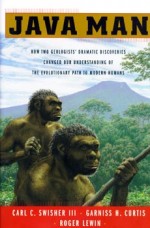
Every semi-well-informed person knows a little something about archaeology, anthropology, and paleontology, even if he or she is not quite sure about the fields’ terminology. News of momentous discoveries like Lucy, thought to be the “missing link” between humans and their ape ancestors, or the Iceman, whose secrets scientists are scrambling to decode, gets splashed across newspapers nationwide, broadcast over television, and reported in periodicals like “Time” on a regular basis. The average person may not be able to tell you who or what these finds are, but chances are he or she is at least peripherally aware of them.
What most of us fail to hear about, however, are the stories behind the headlines. Scientific fields, particularly those that deal for a great part in theory, are fiercely competitive and rife with dissent; researchers cling to cherished hypotheses and refute all contradictory evidence, scientists compete with each other for funding and access to dig sites, and conflict between scholars in professional organizations affects the findings they present to the public.
Java Man, a collaborative effort by Carl Swisher III, Garniss Curtis, and Roger Lewin, brushes away the layers of deception and reveals in unyielding detail the bare bones of the scientific community. The book, which chronicles geologists Swisher and Curtis’s work in their search for the origins of humanity, is two-pronged: roughly half of Java Man explains the impact of previous research, including how important discoveries get ignored because they don’t fit in with the accepted scheme of things, and follows the geologists’ work in Java. The other half is a passionate account of what happened when they presented their findings.
As the authors are quick to point out, archaeology, geology, and anthropology are fields that house tremendous egos, some of which were less than pleased with the team’s findings. Specifically, there were many scholars who found the human fossils dated by Swisher and Curtis unreliable, and who viewed the geologists’ search for answers in Java with suspicion, condescension, and even contempt.
Accusations of improper funding and bad testing were the least of the more cantankerous skeptics’ tactics; for example, in an unrelated incident, but one which demonstrates the level of maturity in these skirmishes, the taunt, “You’re all f**** nerds!” echoed back and forth through the halls of the Institute of Human Origins and its affiliated Geochronology Center.
It is obvious that the authors and publishers of Java Man are capitalizing heavily on their “behind the scenes” approach to science. The summary on the dust jacket uses words like “maverick” and phrases such as “lucid prose” and “infectious enthusiasm.” It ends with the statement that the book “raises philosophical questions about what it means to be human,” and touts Java Man as a science book for people who aren’t scientists.
Nonetheless, any reader who peruses this book needs a moderate level of interest in anthropology and the related fields. It is a simple fact that, short of dumbing one’s text down to high school textbook level, a technical subject necessitates a technical approach; this is not to say that all scientific books must read like dissertations, but certainly there must be some amount of data or the work loses substance. Java Man is no exception. While the authors leaven their data with personal anecdotes and buoyant prose, the reader must still remember the difference between Pithecanthropus and Homo erectus, and distinguish the taxonomic family Pongidae from Hominidae.
However, there are many reminders throughout the text and the authors’ explanations are clear and relatively non-technical, so the task is not overly difficult.
Swisher sums up the need for research about our past in this way:
“Discovered some six decades ago, the [Mojokerto child’s] cranium has no face and no jaw; and yet, bereft as it is of any recognizable physiognomy, the small, rounded object still elicits a sense of awe in the observer, a connection with a distant past, not so much forgotten as unknown, perhaps even unknowable. Frustrating as they are in their muteness, relics such as these have drawn anthropologists into the search for human origins for more than a century. Their aim is at once the scholarly pursuit of uncovering our species’ evolutionary history and a personal mission of understanding what made us human. Hold a fossil like Mojokerto in your hand, and you have what is at the same time the object of scientific investigation into the byways of human prehistory and a petrified moment of your own ancestry.”
The discoveries we make today shape our understanding of our past, not only through the uncovering of “new” artifacts and fossil evidence, but through the re-evaluation of previously unstudied finds. If we blindly accept “the way things are” without questioning why these theories exist, we will perpetuate a misguided image of prehistory in general and evolution in particular; especially insidious are the theories with ostensible scientific foundations but with a thick coating of value-laden assumptions that use race or lifestyle to explain differences. In Java Man, the first steps toward public awareness of the real anthropological stories have been taken, and they are an unquestionable success.






